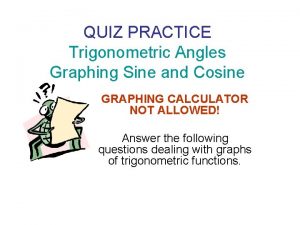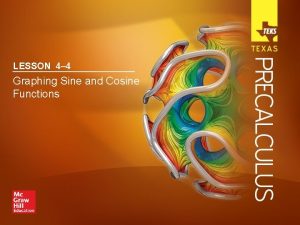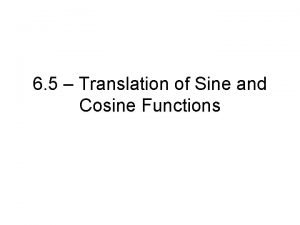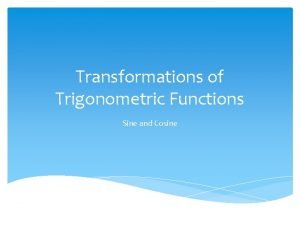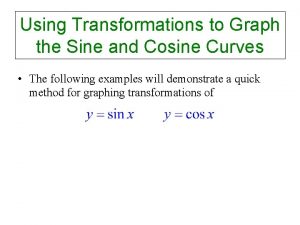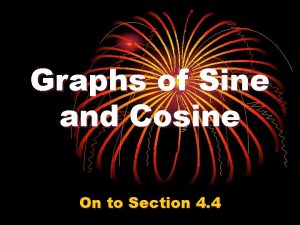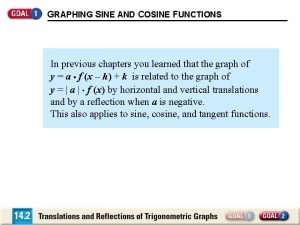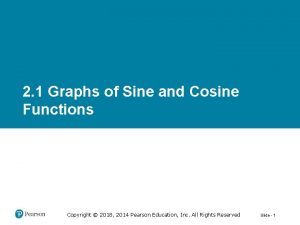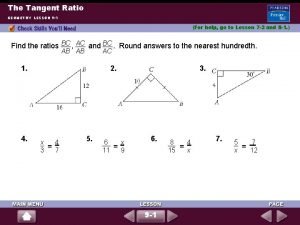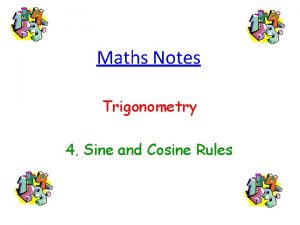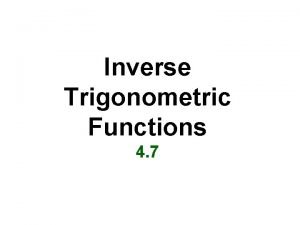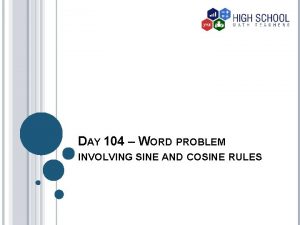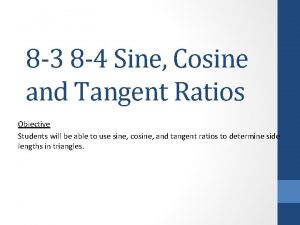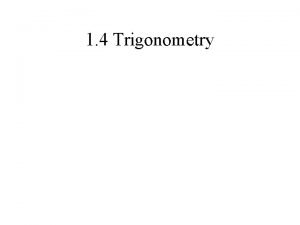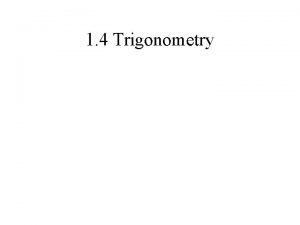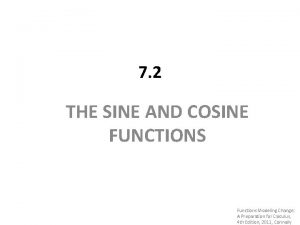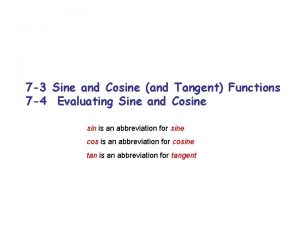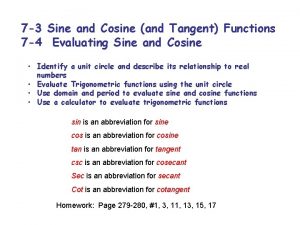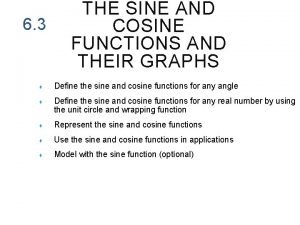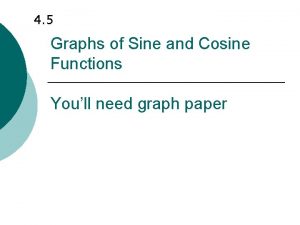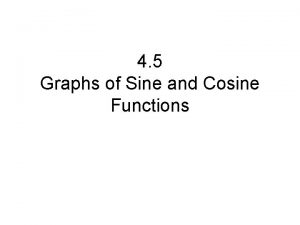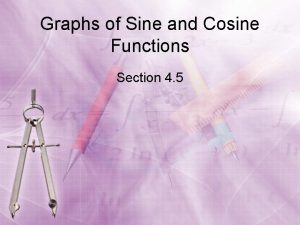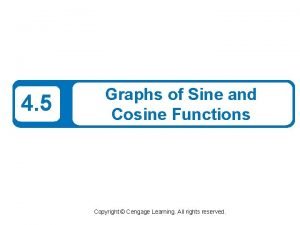6 5 Translation of Sine and Cosine Functions



















- Slides: 19

6. 5 – Translation of Sine and Cosine Functions

Phase Shift • A horizontal translation or shift of a trigonometric function • y = Asin(kθ + c) or y = Acos(kθ + c) The phase shift is -c/k, where k > 0 If c > 0, shifts to the left If c < 0, shifts to the right

State the phase shift for each function. Then graph the function. 1. y = cos(θ + π) 2. y = sin(4θ – π)

Midline • A horizontal axis that is the reference line or the equilibrium point about which the graph oscillates. – It is in the middle of the maximum and minimum. • y =Asin(kθ + c) + h or y =Acos(kθ + c) + h The midline is y = h

Vertical Shift • y =Asin(kθ + c) + h or y =Acos(kθ + c) + h • The vertical shift is h The midline is y = h If h < 0, the graph shifts down If h > 0, the graph shifts up

State the vertical shift and the equation for the midline of each function. Then graph the function. 1. y = 3 sinθ + 2

Putting it all together! 1. Determine the vertical shift and graph the midline. 2. Determine the amplitude. Dash lines where min/max values are located. 3. Determine the period and draw a dashed graph of the sine or cosine curve. 4. Determine the phase shift and translate your dashed graph to draw the final graph.

Graph y = 2 cos(θ/4 + π/2) – 1

Graph y = -1/2 sin(2θ - π) + 3

6. 6 – Modeling Real World Data with Sinusoidal Functions • Representing data with a sine function

How can you write a sin function given a set of data? 1. 2. 3. 4. Find the amplitude, “A”: (max – min)/2 Find the vertical translation, “h”: (max + min)/2 Find “k”: Solve 2π/k = Period Substitute any point to solve for “c”

Write a sinusoidal function for the number of daylight hours in Brownsville, Texas. Month, t Hours, h 1 2 3 4 5 10. 68 11. 30 11. 98 12. 77 13. 42 6 7 8 9 10 11 12 13. 75 13. 60 13. 05 12. 30 11. 57 10. 88 10. 53

1. Find the amplitude Max = 13. 75 Min = 10. 53 (13. 75 – 10. 53)/2 = 1. 61

2. Find “h” Max = 13. 75 Min = 10. 53 (13. 75 + 10. 53)/2 = 12. 14

3. Find “k” Period = 12 2π = 12 k 2π = 12 k π/6 = k

4. Substitute to find “c” y = Asin(kθ – c) + h y = 1. 61 sin(π/6 t – c) + 12. 14 10. 68 = 1. 61 sin(π/6 (1) – c) + 12. 14 -1. 46 = 1. 61 sin(π/6 – c) sin-1(-1. 46/1. 61) = π/6 – c 1. 659… = c

5. Write the function y = 1. 61 sin(π/6 t – 1. 66) + 12. 14

Homework Help • Frequency – the number of cycles per unit of time; used in music • Unit of Frequency is hertz • Frequency = 1/Period • Period and Frequency are reciprocals of each other.

Assignment Guide Changes • Today’s work: 6. 5 p 383 #15 – 24 (x 3) – now draw the graphs 6. 6 p 391 #7 -8, 13, 22 -23 • Quiz on Wednesday over 6. 3 – 6. 5
 How to find period of a sin graph
How to find period of a sin graph 9-5 practice graphing trigonometric functions
9-5 practice graphing trigonometric functions Lesson 4 the sine function
Lesson 4 the sine function 4-4 graphing sine and cosine functions
4-4 graphing sine and cosine functions 6-5 practice translations of sine and cosine functions
6-5 practice translations of sine and cosine functions Trig function transformations
Trig function transformations Graph transformations
Graph transformations Graph of sine and cosine functions
Graph of sine and cosine functions Phase shift sin
Phase shift sin Sinusoidal graphs
Sinusoidal graphs Transformations of sine and cosine functions
Transformations of sine and cosine functions Lesson 13-2 sine and cosine ratios answer key
Lesson 13-2 sine and cosine ratios answer key What is the sine and cosine rule
What is the sine and cosine rule Sine and cosine law maze
Sine and cosine law maze Cos clicker
Cos clicker Trigonometry cosine rule
Trigonometry cosine rule Sin inverse sin x is equal to
Sin inverse sin x is equal to Sine and cosine rules
Sine and cosine rules Sine and cosine law word problems
Sine and cosine law word problems Practice 8-4 sine and cosine ratios answer key
Practice 8-4 sine and cosine ratios answer key

